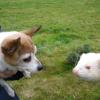-
Content Count
357 -
Joined
-
Last visited
Content Type
Profiles
Forums
Gallery
Articles
Gun Dealer's and Fieldsports Shop's
Reloading Room
Blogs
Calendar
Store
Classifieds
Everything posted by Meroman
-
I have three flights 14ft x 5ft x 8ft in height, I house 3 to 4 pairs of different species of native finches in each flight during the breeding season. In a 6ft x 6ft flight depending on the height 4 or 5 hen canaries with 3 cocks would be fine but if you intend breeding natives I'd say 2 pairs is enough in a flight this size. Generally speaking canaries are bred in smaller cages but if you just want to keep a few birds in a flight for the enjoyment of it a couple of pairs of canaries and maybe a pair of greenfinches and a pair of siskins or redpolls would be ideal to start off with...
-
Its the middle of the breeding season and buying birds now is not the best time, wait until the moult is finished then buy current year birds when breeders are moving on their surpus stock.
-
Craigy is spot on with the advice he has given just to add, check every morning if she has laid and when she lays her first egg take it out and replace it with a dummy egg, repeat this every morning until she has finished laying that way you can leave the goldy in with her and not worry about him smashing eggs plus you are increasing the chances of him treading her if he's in all the time. Reading your post about her missing feathers I'd say the goldy is driving her hard to nest. When she stops laying take the goldy out and replace the real eggs, she will sit the eggs for 14 days and you are
-
Nice looking birds. I like the fawn & white..
-

What's the best canary for breeding mules
Meroman replied to andy p's topic in Cage and Aviary Birds
Sound information Old Hand I agree 100%. May I add that if you are breeding miniature mules for exhibition an Irish/fife cross canary hen in my opinion is best because the mules from them tend not to have snipey head of the Irish and have better shape or type inherited from the fife. -
Gnipper you were right, the cages are still for sale on NBTMH................ ''block of 30 cages for sale only about 12 months old come with all fronts ready to go now very cheep at £100 st helens area, tel alan on 07403487803'' Diezel this lad is in Merseyside if it helps...
-
Great to see, a credit to you.....
-
Keep the cock out for another day or so.She should continue feeding the chick while shes building, obviously you need to put the cock back in to tread her but the risk is she may be driven hard by the cock to nest again and abandon her chick. You could also top up the chick with some eggfood ensuring its getting enough food...
-
As fireman says it takes time for any bird to settle after being moved to a new envoirement plus it is still dealing with the stress of being transported from A to B. When it settles you will hear it sing....
-
Christian, Gnipper knows his stuff. So I'm sure he will fill you in on the finer details when you visit him....
-
1 Whats best on the floor gravel, bark, soild floor etc A concrete floor is best, put a layer of 1/4'' wire down before pouring the concrete to ensure its rodent proof. 2 What plants Plants are not neccessary, the birds usually strip any plants in an aviary. 3 Do they need shelve's to put conifers on, or some cover etc No shelves, just cover conifer is good. 4 Whats best on the roof will have wire front, both side's and back will be timber A perspex roof will give you ample light, use wire on the roof as well. double wire with a 2'' or 3'' gap on the front so hawks or
-
Some nice birds there & a lovely set up......
-

Exhibition breeder of red dimorphic canaries
Meroman replied to Fleetwood Lad's topic in Cage and Aviary Birds
Check out the link below, its your best chance of getting the birds you need from genuine colour canary men. After the moult there are generally lots of birds available. http://colourcanary.forumotion.net/ -
Generally speaking canaries are bred indoors in a bird room in cages but they can be bred outside in aviaries or flights as well. They do not need heat during the winter but some breeders use temperature controlled heaters in very cold weather to prevent drinkers freezing plus to keep the birds fit in extreme weather conditions. People who breed canaries for exhibition use cages to breed selected pairs but if you are justing keeping them for their song/the enjoyment of it then an outdoor aviary is fine they will colony breed.
-
Great pics Fireman, good to see you are doing well this breeding season......
-
Some people hang cd's around their flights to deter sparrowhawks Never tried it myself but some swear by it
-
Gnipper you are doing a great job with your breeding season....
-
been sitiing tight for nearly a week mate. Take the nest pan out for 3 or 4 days then replace it, she should then start laying again.... With regard to ringing your redpolls, they are probably the hardest natives to ring but in my opinion if you breed any natives be sure to ring them & keep breeding records, ie ring numbers of the parents, date they hatched, date they jumped the nest, ring numbers etc etc. I agree the law in the uk does not require you ring your birds and you can not sell them or exhibit them if they are unrung but if you got a knock on the door and you had unrung
-
Thanks for the comments everyone. Those photo's are a couple of years old now. I bred some greenfinch mules from the Greenie/Irish fancy canary & they had good colour but were too small to show as standard mules & too big to show as miniature mules. I got one hen from the goldie trio to breed and rear 3 young. The cock goldie in the show cage has size, colour,good tannins and was steady in the show cage but his blaze is not the best, its rounded & not square plus its broken. The hen siskin in the flight is the mother of the hen in the show cage who won a class or two for me but
-
I agree jjm, I've had a lot of dead in shell chicks due to the hens jumping the nest because of the cold weather......
-
It was bred off a clear yellow Norwich hen, I did'nt breed the bird myself a mate of mine bred it. I colour fed it with carophyll red and overdid it a bit, its burnt from too much colour food.
-
Here's a few photo's of my birds.........................
-

How long would a canary hen x goldie egg keep for?.
Meroman replied to fireman's topic in Cage and Aviary Birds
If you take them indoors and store them at room temerature they will stay good for 5-7 days in my opinion, a good tip is to turn them a couple of times a day. -
As has been said above natives dont come into breeding condition until at least late April if they are being kept without artificial light & temperature. I agree goldfinches are usually later than other natives coming into breeding condition, lots of people take a round of canaries off a hen before they try for mules. The colour of the hen canary makes no difference, the native will thread her either way if he is in breeding condition. In reply to Francolin, bullie chicks have a big wide gape which is bright red and puts off canary hens that have reared canary chicks previously so if


